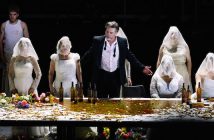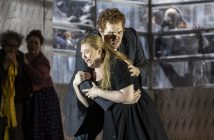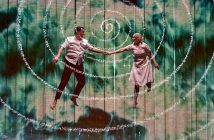Since premiering in 2005, this highly acclaimed English National Opera Madam Butterfly production went on to win Anthony Minghella an Olivier Award and remains the only opera ever directed by him. The director’s untimely death lends an air of tragedy to the production – hailed as a masterpiece around the world for its beautiful choreography, set design, and interpretation.
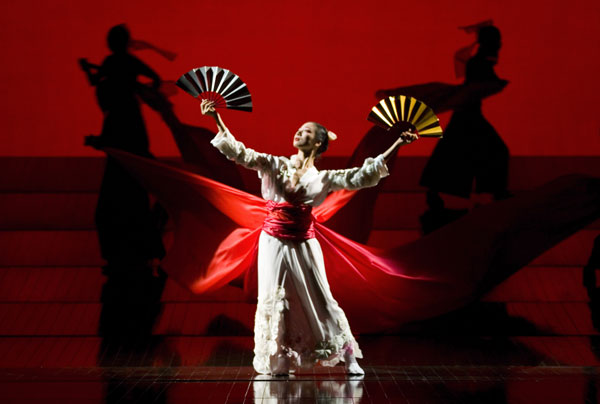
This is the fourth revival of Minghella’s Madam Butterfly at the London Coliseum and vividly brings to life Puccini’s celebrated tale of unrequited love, betrayal and loss. First premiered in 1904, Madama Butterfly soon became one of the best loved operas, famous for its heartbreaking climax and goose-bump-inducing arias including Un bel Di Vedremo (One Fine Day). Part of the reason Minghella’s production is so successful is thanks to the stark yet highly sophisticated set design by Michael Levine – effectively enhanced at various times with paper lanterns, fans, sliding Japanese screens and flowers – a visual sensation when partnered with brilliant and atmospheric lighting by Peter Mumford.
Madam Butterfly explores the tragic downfall of a Japanese geisha girl and opens on a hillside in Nagasaki. Soprano Mary Plazas plays the title role Cio-Cio-San (Madam Butterfly), perfectly capturing the innocent and devoted love she feels for American naval Lieutenant Pinkerton who, hours before his wedding to her, declares to his friend Sharpless that he will later find a good American woman for his wife and discard his bride. Cio-Cio-San in turn happily relinquishes her friends and family in order to honour her husband. 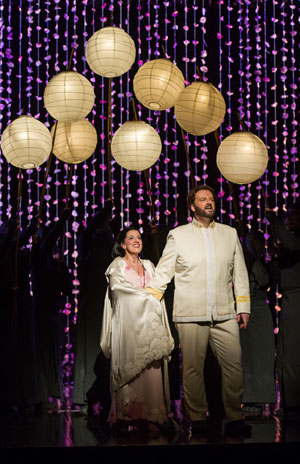 With a stature of under five foot, Plaza’s physical size makes it far more believable to play the 15-year-old geisha, ‘so very tiny’, as Pinkerton sweeps her into his arms at the end of Act 1, allowing her to fully channel the vulnerability of the character in a way seldom seen.
With a stature of under five foot, Plaza’s physical size makes it far more believable to play the 15-year-old geisha, ‘so very tiny’, as Pinkerton sweeps her into his arms at the end of Act 1, allowing her to fully channel the vulnerability of the character in a way seldom seen.
Minghella – who had a clear vision for the overall look and feel of the production – called on Chinese fashion designer Han Feng to design the costumes. Feng found inspiration in traditional Japanese dress, David Hicks wallpaper samples, and contemporary fashion – especially the work of John Galliano – clearly seen in the startlingly vibrant costumes she designed for the geisha chorus in Act 1, described as ‘a riot of colour’ by one reviewer. Her work gained much attention from the opera world and unsurprisingly opened the door to many other costume commissions for Feng, who is currently working on a new Royal Opera House production.
The robust Welsh tenor Gwyn Hughes Jones makes a convincing Pinkerton – a man unashamedly abusing the Japanese law allowing marriages to be dissolved on a monthly basis for his own pleasure. Although, in Japanese culture it is unlikely that a geisha would have viewed the marriage as anything other than a business transaction, this is an opera after all, and a highly cinematic tribute to one at that. Butterfly believes her ardent feelings are reciprocated and Act II sees Cio-Cio-San in denial of her abandonment by Pinkerton and her deep love for the son ‘Sorrow’ she has borne him.
‘Sorrow’ – a small child dressed in a sailor outfit, is in fact an ingeniously choreographed puppet – cleverly manoeuvred into Cio-Cio-San’s arms by three darkly clad puppeteers of the Blind Summit Theatre and reminiscent of traditional Japanese puppet theatre. The success or failure of this was a hotly debated topic when the production first premiered and still divides audiences today – for me the puppetry is not only artful in itself but shows the brilliance of the choreography and Mary Plaza’s acting ability as she embraces the child so tenderly, singing ‘Con onor muore’ (To die with honour) as we head towards the climatic and agonising close.
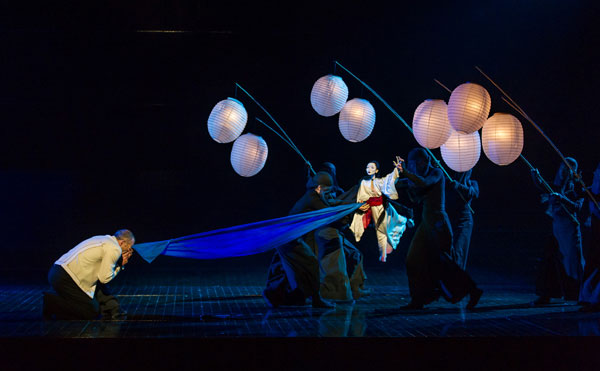
This Madam Butterfly, sung in English, is an altogether mesmerising experience, harmonising contemporary staging with classic operatic drama, and there is every reason why Minghella’s production will be returned to for many years to come.
Visit www.eno.org for the full Autumn/Winter 2012 programme.

